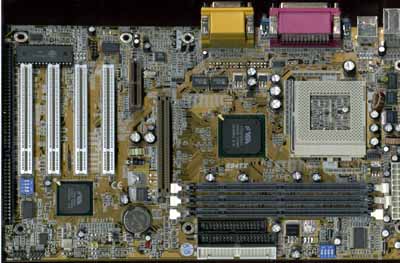VIA Apollo Pro 133A Motherboard Roundup - July 2000
by Anand Lal Shimpi on July 21, 2000 5:31 AM EST- Posted in
- Motherboards
Azza 694TX
|
Azza 694TX Specifications |
|
| CPU Interface |
Socket-370
|
| Chipset |
VIA
Apollo 133A
VIA 694X North Bridge VIA 686A South Bridge |
| L2 Cache |
N/A
(on-chip)
|
| Form Factor |
ATX
|
| Bus Speeds |
66
/ 68 / 75 / 83
95 / 100 / 103 / 112 124 / 133 / 138 / 140 / 150 / 160 / 166 |
| Voltages Supported |
Auto
Detect
|
| Memory Slots |
3
168-pin DIMM Slots
|
| Expansion Slots |
1
AMR Slot
1 AGP Slot 4 PCI Slots (3 Full Length) 1 ISA Slot (1 Shared / 1 Full Length) |
| Onboard Audio |
VIA
VT1611A AC'97 CODEC
|
| BIOS |
AWARD
BIOS 6.00PG
|
Azza is a newcomer to AnandTech and their first board is the 694TX. The actual PCB is quite small, slightly longer than an ISA slot, which is about as small as you can get and still be a standard ATX board. That PCB is very well laid out with power and IDE/FDD connections at the front of the board where they should be. The 694TX is one of the few boards in this roundup to not include a heatsink atop the North Bridge. Fortunately for Azza, this did not seem to affect stability as the board was quite stable.
The 694TX uses a jumperless CPU setup that auto detects the intended CPU FSB speed and, based on that, offers a small range of settings to overclock your CPU. A 4 position DIP switch allows you to override the detected setting so that you can overclock your CPU beyond the default range - e.g. a 66 MHz Celeron can be run at 100 MHz with the override DIP switches set correctly. Unfortunately for overclockers, while a jumper on the motherboard is listed as enabling various core voltage ranges, it does not appear that this voltage can be manually adjusted by the user.
Our biggest problem with the 694TX is that there are only 4 PCI slots available to fill your expansion needs. Further, for those of you planning to use a 66 or 100 MHz FSB CPU, the 694TX does not support running the memory bus faster than the FSB speed - a bit odd considering this is one of the main features of the VIA 133A chipset.
Otherwise, the 694TX does very little to stand out from the crowd.











0 Comments
View All Comments